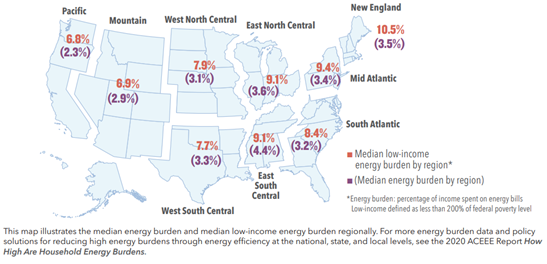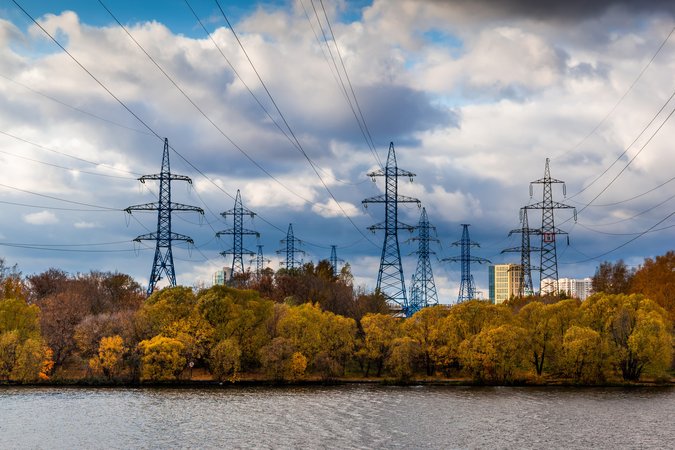Electricity Affordability 101
This explainer discusses the elements of the energy transition that could affect electricity costs for consumers and describes potential economic and policy levers that could mitigate these costs.
Decarbonizing the economy is essential to avoiding the worst harms of climate change. At the core of this transition is the decarbonization of the electric grid and electrification of other energy uses. While the societal benefits of these investments have been shown to exceed costs in the long run, decarbonization policies raise questions about impacts on household electricity costs, especially for those households already struggling to keep up with utility payments. This explainer first discusses the elements of the energy transition that could affect electricity costs for consumers and then describes potential economic and policy levers that could mitigate these costs.
Is electricity affordable today?
Electricity prices across the US already vary widely by state depending on regulations, generation mix, infrastructure investments, subsidies, public policy-related costs, fuel costs, regional climate, and other factors (Figure 1).
Average US Electric Industry Revenue by State in May 2022 (cents/kWh)

A common metric used to assess energy affordability more broadly is known as a household’s “energy burden." Energy burden is represented as the percent of a household’s income that is spent on energy. While this measure includes other energy uses (such as gas to heat homes and operate cooking appliances), it can still tell us about how affordable electricity is for different income groups. Including other energy spending also helps control for when households switch between fuel types for home energy needs. Spending more than 6 percent of income on home energy (including electricity) is considered highly burdensome. For many, electricity is already unaffordable. ACEEE research in 2020 found that 25% of low-income households experience energy burdens greater than 6%. Figure 2 shows the average energy burden in each state, which varies according to each state’s average household income, energy demand, and energy prices. As electrification continues, energy burden will be a relevant measure for helping policy makers contextualize changing energy costs.
Median Energy Burdens by Region for Low-Income Households

Low-income households tend to suffer disproportionately with higher electricity prices. Figure 3 uses two example regions to demonstrate that electricity bills do not decrease proportionately with income, demonstrating why energy burdens for low-income households can be extremely high. Energy efficiency programs aim to reduce the burden of these bills, but research indicates low-income households rarely participate in those programs (Johnson et al 2017, Sigrin and Mooney 2018, Monyei et al 2019). As we discuss impacts of decarbonization on electricity prices, it is important to keep these distributional effects in mind.
Electricity Bills by Income for Two Sample Utilities

Beyond the disproportionate energy cost burden, evidence shows low-income households are often driven to limit their energy consumption by high energy costs. This can lead to reduced benefits from electric appliances, and even negative health outcomes associated with insufficient cooling or heating in the home. Because, energy burden does not capture these impacts, understanding households’ baseline energy needs—regardless of ability to pay—will be important.
Electricity affordability also has implications for decarbonization because electrification incentives depend on the cost of electricity relative to other fuel options. Lucas Davis of UC Berkeley finds that electricity prices are responsible for 80 percent of the historical increase in electrification of home heating in the US, which grew from 1 percent in 1950 to roughly 40 percent in 2020. So, policies that disproportionately increase electricity costs over other forms of energy, such as natural gas, will be problematic. Research by Severin Borenstein and James Bushnell finds that, in the most populous parts of the country, electricity prices are higher than their social cost, while gasoline and natural gas are underpriced relative to their social cost. Such misalignments discourage socially beneficial electrification of transport and other appliances.
What emerging trends threaten electricity affordability?
While electricity affordability is an ongoing problem, there are several elements of the energy transition that could directly impact the costs of electricity and energy more broadly. Below we discuss them and how they might impact prices.
Infrastructure Investments
Infrastructure investments across the electric grid will be critical to decarbonization. According to a recent National Academy of Sciences study, putting the economy on the path to net zero by 2050 will require $2.1 trillion in new investments over the next decade, roughly half of which will be related to electricity generation, transmission, and distribution. The US Energy Information Administration estimates that for wind and solar built between 2022 and 2027, the levelized cost of transmission investment required to connect with the grid would be between 2 and 4 times higher than that required for a new combined cycle or geothermal resource (in the Annual Energy Outlook reference case). A 2022 Berkeley study estimates that the distribution system upgrades in Pacific Gas and Electric Company territory required to meet California’s electric vehicle (EV) targets (3 million cars in 2030 and 12.5 million in 2050) will require $1 billion in distribution system investments by 2030 ($5 billion by 2050). Without the policy interventions described in the next section, these costs will fall largely on ratepayers.
New Technology
To advance decarbonization goals, policies can encourage new technology adoption and development. These policies include technology mandates (minimum amount of new storage, solar, or offshore wind) that may be costly in the short run but could reduce costs in the long run by incentivizing new investments and cost-reducing improvements in existing infrastructure.
Some technologies critical to the transition have not been fully developed or deployed yet, including long-term energy storage and advanced nuclear technologies. Bringing these technologies to market on the scale needed for decarbonization will take large investments in research and development, like those supported in the Infrastructure Investment and Jobs Act. Some technologies will prove to be well worth the investment, while others will likely never become economic. These advances may be funded in part by private investors willing to take the risk, but the costs of development will also likely be reflected in the price of technologies that eventually do come to market.
On the household level, the up-front costs of EVs and certain electric appliances are more expensive than traditional fossil technologies in use today. Subsidies, reduced fuel costs, and maintenance savings often fill this gap, but upgrading to electric technology can still present a high up-front cost.
Paying for Legacy Costs
Because the electrification transition is likely to take some time, there will be a period when new infrastructure is being built alongside legacy systems like gas pipelines and distribution systems. Access to electric technologies (induction stoves and heat pumps) will be easier for higher-income households who can afford the up-front costs, while others continue to use gas appliances and furnaces. Newly published work finds that when the customer base for natural gas utilities shrinks, bills for remaining customers increase, disproportionately impacting low-income and disadvantaged customers with fewer opportunities to upgrade appliances.
Fluctuations in Costs
As the mix of generators used to produce electricity evolves, consumers may face more variable electricity prices. A decarbonized grid will feature a greater role for variable generation, including wind and solar that has essentially zero marginal costs. Recent RFF analysis of the clean electricity tax credits embodied in the Inflation Reduction Act found that roughly 70 percent of the capital costs associated with these climate policies are offset by reductions in future fuel costs (relative to a baseline without those policies).
Once the grid is substantially decarbonized, wholesale electricity prices can be very low when natural energy resources like sun and wind are available. However, these prices will also experience spikes when wind speeds are low or the sun sets. Recent research from MIT’s future of energy storage study suggests that with strict emissions constraints, wholesale prices in ERCOT will be under $5 per MWh in 80 percent of the hours, over $200 per MWh in 15 percent of the hours, and well above $1000 MWh in the highest price hours of the energy market To avoid higher average electricity costs, households must be incentivized to adjust their consumption toward lower-cost periods of electricity generation. Without behavioral changes, utilities may charge higher rates to recoup generation costs incurred in these expensive periods.
Capacity and Reliability
The intermittency of the new generation mix in a decarbonized grid will also present challenges in the capacity market, which seeks to ensure there is enough generation capacity at any given time to meet potential demand. Regions with capacity markets assign values, known as Effective Load Carrying Capability (ELCC), to different generators that reflect their reliability in delivering electricity on demand. While these values are often contested, renewables generally have a lower ELCC than fossil fuel generation due to the lack of control operators have over their “fuel” (the sun and wind). This means that, to be compensated for the same amount of effective capacity, renewable generators will have to be able to deliver more electricity than their fossil fuel competitors, driving up capital costs. This is exacerbated when more renewables come online and have correlated outages, requiring increased investment in long term storage and other firm, dispatchable clean energy sources. The costs of these investments to ensure reliability will be embedded in the cost of electricity.
Adapting to Climate Change Will Require Energy
Beyond investment and the changing generation mix, climate change itself will create strains on the electricity system. Rising temperatures will increase demand for air conditioning and other energy uses (Figure 4). Extreme weather events like wildfires, winter storms, and flooding will also threaten grid infrastructure, requiring greater investment in resilience measures. As policymakers plan for future infrastructure needs and strive to manage electricity prices, it is important to recognize the role environmental factors will play in shaping demand and hazards to infrastructure.
Hourly Temperature in Select Cities and Electricity Demand (2019–2020)

What solutions might offer relief?
Despite the new investments and costs that utilities, governments, and households will face, there is also a wide variety of opportunities to reduce energy burdens. Below we discuss a few of these solutions and how they could provide relief.
Flexible and Price-Responsive Demand
As mentioned, renewable energy from wind and solar is intermittent, and a grid that relies heavily on these resources will have periods with very low-cost energy and those with high-cost energy. These fluctuations will create new challenges for investors and elevate the importance of storage and demand flexibility mechanisms. “Demand response” refers to the practice of lowering peak electricity demand to ease strain on transmission, distribution, and generation systems. Similar to how utilities pay for electricity supply, utility companies can compensate consumers to demand less electricity. It is important to note that access to the automation and energy management services that enable flexible load—and relieve consumers of responsibilities of paying attention to prices—may be uneven. Homes that use older devices may not have the same capacity to respond to market signals and may end up paying higher prices as a result.
Rate Design
The effectiveness of demand response and other load management policies will be impacted by electricity rate design. Exposure to time-varying prices based on the cost of electricity supply is essential to enabling demand response technologies. Research indicates that real-time retail pricing is increasingly beneficial in a system with more renewables, due to wider price ranges and the ability of consumers to respond to those prices to secure savings. Additionally, covering the fixed cost of electricity service in a per kWh rate contributes to high prices and inefficiency, and those fixed costs will continue to rise due to investments in resilience, wildfire hazard mitigation, distribution grid upgrades, and a variety of other factors. Finding ways to recover fixed costs that don’t impact per kWh electricity rates and that allow those fixed charges to vary by income could be an efficiency- and equity- enhancing innovation. The California Public Utility Commission staff have recommended a variety of rate design proposals that hope to address these concerns, including dynamic time-of-use and a subscription service model that would allow customers to lock in payments for different electricity use patterns at a fixed price based on their historical use.
Regional Connection and Storage
One way to address correlated supply-side outages associated with wind and solar is to establish greater inter-regional connection through investments in transmission. While it will require up-front investment, greater regional connection will allow ratepayers to take advantage of lower prices by increasing access to a wider generation mix and will reduce the risk of intermittent resources being offline at the same time. The Western Energy Imbalance Market is one example of states increasing regional connection to resources. This shared market reduces the need for capacity investments and gives participants access to lower-cost resources outside of their balancing area. The Western Energy Imbalance Market operator claims to have delivered over $2.1 billion in savings to participants between 2014 and 2022, compared to continued regional market isolation.
Carbon Pricing
Some states (including the RGGI states, California and Washington) use cap and trade to efficiently reduce CO2 emissions. These state programs work by auctioning limited numbers of emissions allowances and raising the cost of fossil fuel use to encourage switching to cleaner electricity production technologies. This method encourages regulated entities to find the lowest cost approaches to decarbonization. Carbon pricing typically raises electricity prices in the near term, but it incentivizes greater deployment of renewables and other clean generators, leading to a reduced impact on electricity prices over time. Additionally, allowance revenues can be used in a variety of ways to mitigate impacts on consumers including providing periodic rebates to electricity consumers (as done in CA) and supporting energy efficiency programs (as done in RGGI). This ability to create revenues that can be used for multiple purposes—including offsetting costs through payments and energy efficiency investments—is an important feature of carbon pricing.
Support from Public Policies
Policies that offer utility bill support or provide subsidies to generators and utilities to cover decarbonization costs can shift the cost burden from ratepayers to taxpayers. For example, many states and the federal government offer programs to assist low-income households with utility bills. While these methods do not eliminate the costs, they can allow policymakers to shift costs over time and to those most able to pay.
One example of government spending to alleviate costs is tax credits for renewable energy expansion. Extended tax incentives for clean electricity are a key part of the Inflation Reduction Act. Recent modeling work at RFF shows that these tax credits will more than offset the increased resource costs in the first 10 years, leading to lower electricity costs.
Key reminders
There are long-term benefits to investing in enhanced infrastructure and new technology. Often, they come with up-front costs. Policy and public spending can offset these up-front costs, particularly for low-income households.
For many, electricity is already unaffordable. Changing climate, electrification, and a transition to a decarbonized grid can create additional costs, but it can also create opportunities for energy savings in the long run. Additionally, communities exposed to emissions and air pollution from burning fossil fuels are often the very same communities burdened by energy prices. They may enjoy significant health benefits from achieving a decarbonized grid. Preventing or slowing decarbonization is not a solution for households currently struggling to pay utility bills.




